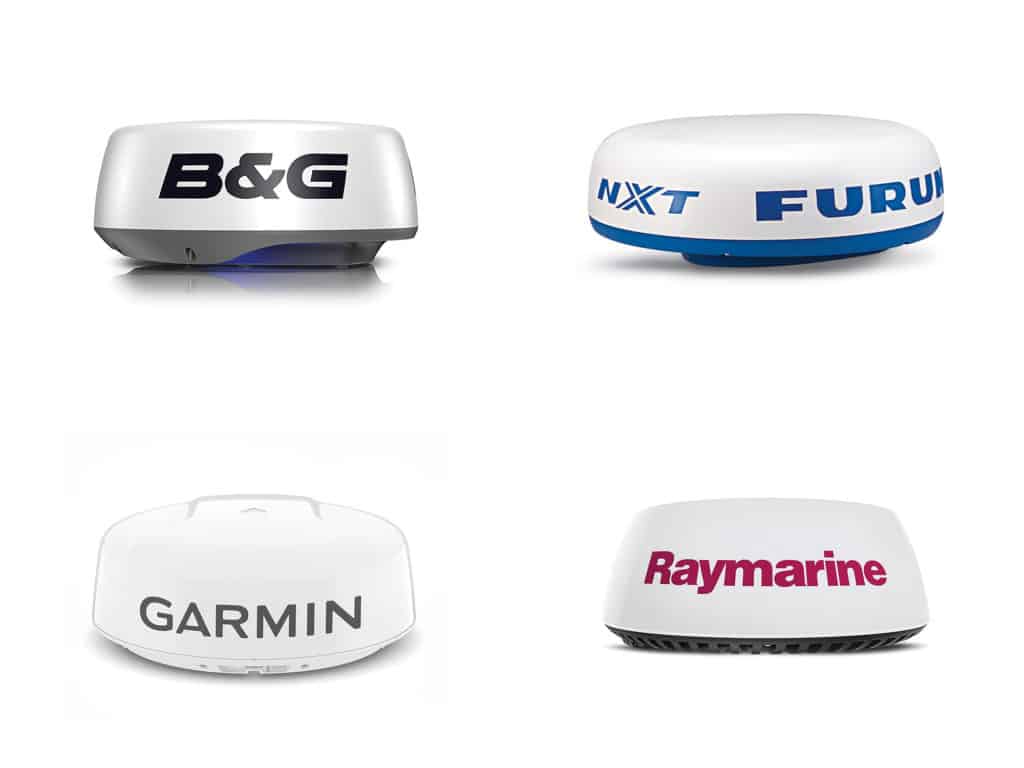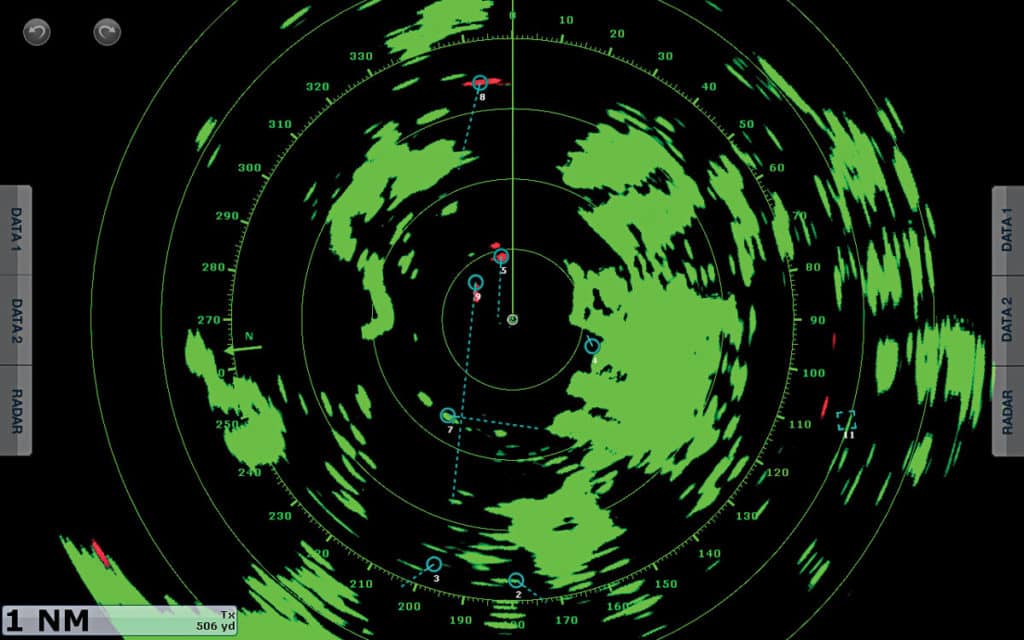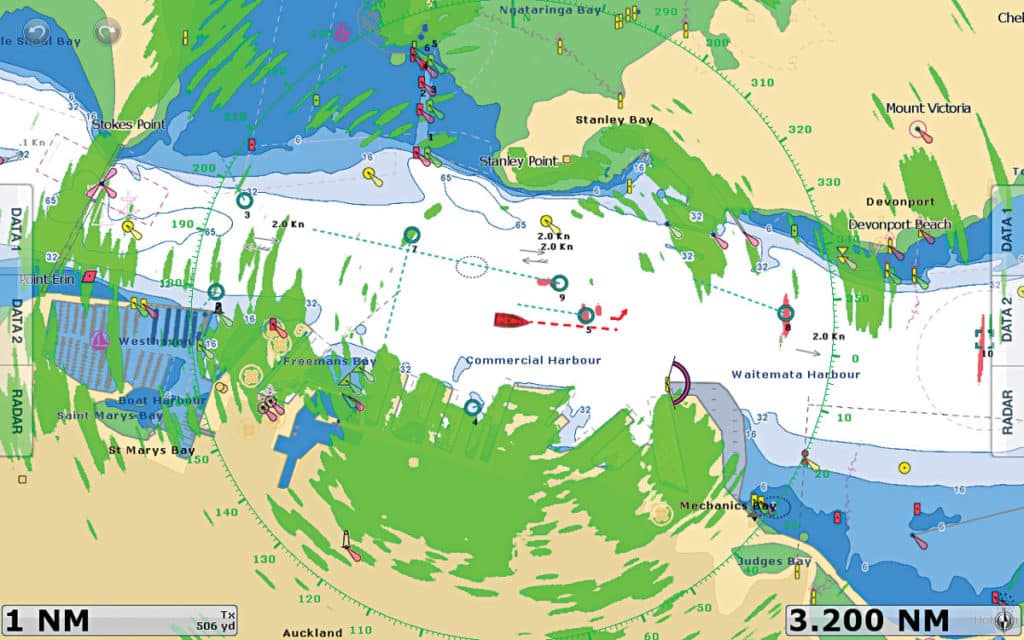
When I was a kid, my dad and I watched an aircraft carrier break apart. At least, that’s what it looked like on his radar, which employed a cavity magnetron transmitter and a monochrome display. The year was 1988, and we were crossing Muscongus Bay, en route from Port Clyde to East Boothbay, Maine. We were aboard Windancer, my parents’ C&C 37, in classic pea-soup fog. Looking at the radar display, we could see something enormous a handful of miles off our starboard bow.
And then suddenly, our “aircraft carrier” dissolved. We rushed on deck and—some tense minutes later—discerned engines and voices through the murk. So much for a Nimitz-class carrier. This was nothing more than a flotilla of small powerboats we called “gnats.” We arrived in East Boothbay safely and in time for dinner, and we still laugh about how that radar’s lack of target separation caused serious, if short-lived, situational-awareness anxiety.
While it’s easy to say that nuclear energy was the decisive technology that helped the Allies win World War II, the truth is that cavity magnetrons and radar-guided anti-aircraft guns played a far bigger role. Flash-forward to the late 1950s, and radar began emerging on commercial and, eventually, recreational vessels. These “pulse-modulated” magnetron radars create pulses of radio-frequency (RF) energy that’s transmitted from a rotating directional antenna. This energy travels at the speed of light in a narrow, horizontal band before bouncing off targets and returning to the antenna as an echo.
While effective, magnetron-based radars have some drawbacks. They sometimes struggle to separate closely spaced targets, and analog cavity magnetron transmitters are subject to temperature swings, aging, and manufacturing variables (from one magnetron to the next) that make it impossible to do Doppler processing on returning echoes.
The marine world began adopting solid-state transmitters in late 2008, and the first recreational Doppler-enabled boat radars arrived in early 2016. These transmitters generate highly predictable frequencies that enable Doppler processing, which lets radar manufacturers color-code radar targets based on their threat level. These radars also deliver far better close-range performance (read: no main bang or blind spots) and weigh less than magnetron-based radars.
Here’s a look at the four best radome-enclosed boat radars for recreational sailors. All of these systems use solid-state transmitters, and deliver Doppler processing and a host of other features. If you still cruise with an old magnetron-based radar, consider upgrading. The costs are not insignificant, but the improved radar imagery is worth it.
Quicklook: 4 Best Radome-enclosed Recreational Marine Radars
- B&G HALO20, HALO20+ and HALO24
- Furuno DRS2D-NXT and DRS4D-NXT
- Garmin GMR Fantom 18x and GMR Fantom 24x
- Raymarine Quantum 2
B&G HALO20, HALO20+ and HALO24
B&G started employing solid-state radar transmitters in 2008. While these systems generated good short-range imagery, their long-range performance didn’t compare to analog pulse-modulated radars. This changed in early 2015 with the arrival of B&G’s Halo open-array, pulse-compression radar, which gave powerboaters great short- and long-range performance.
B&G’s latest radome-enclosed, solid-state radars—the HALO20, HALO20+ and HALO24—build on this performance and add Doppler processing (plus MARPA target tracking) in a sailing-friendly radome that won’t accidentally ingest running rigging.
As with all radars, greater power and a bigger antenna translate to greater range and better imagery. To this end, the HALO20 operates on 20 watts (maximum consumption) and spins its 17.5-inch antenna (which is fit inside a 20-inch radome) at 24 revolutions per minute to provide 24 nautical miles of range; its big brother, the HALO20+, employs the same antenna, but it spins it at up to 60 rpm (this is dynamic, depending on the range involved) and operates on 29 watts of power for 36 nautical miles of range.
Both 20-inch HALO radars come with optional preset user modes that include harbor, offshore, weather, north up and course up. The HALO20+ also comes with a fishing-friendly bird mode and dual-range capabilities. The latter allows a user to split the radar screen in half, with one side running at, say, 10 nautical miles, while the other is set to maximum range.
The HALO24 boat radar is aimed at sailors seeking greater range. It employs a 22-inch antenna inside a 24-inch radome that it spins at up to 60 rpm. It operates on 29 watts for a range of 48 nautical miles. The HALO24’s bigger antenna allows it to generate smaller beam widths, which further helps the radar to separate targets onscreen. It has the same preset operating modes as the HALO20+.
All three radome-enclosed HALO boat radars are built to IPX6 standards, and all play nicely with B&G chart plotters.
Furuno DRS2D-NXT and DRS4D-NXT

Furuno has long enjoyed a strong reputation for magnetron-based radars, and was the first marine company to unveil a radome-enclosed, Doppler-enabled radar. The DRS4D-NXT could differentiate dangerous and passive targets onscreen using proprietary and Doppler-based features, which operate much like a layer on an electronic chart. Users can turn it on or off, depending on conditions.
Furuno also bundled full ARPA capabilities into the system, which allows the radar to acquire and track up to 40 targets automatically. Users can manually enter 60 additional targets, which the system then also tracks.
However, the DRS4D-NXT has a 22- to 22.5-inch antenna inside its 24-inch radome and weighs 16.1 pounds, making it better-suited for larger sailboats. Enter the DRS2D-NXT boat radar, which Furuno released in 2022. This ARPA-enabled system comes bundled in a 19-inch radome, which houses its 17- to 17.5-inch antenna, and weighs 14.3 pounds. It’s an easier fit aboard smaller rides.
While both systems transmit at 25 watts and spin their antennas at variable speeds for 48 nautical miles of awareness, there are some differences.

As mentioned, radars that transmit tighter RF beam widths generally yield better target separation than systems with wider beams. While both radars have vertical beam widths of 25 degrees, the DRS4D-NXT has a horizontal beam width of 3.9 degrees, while the DRS2D-NXT’s beam is 5.2 degrees. Also, the DRS4D-NXT comes with a bird mode, which is likely more applicable to anglers than sailors.
Otherwise, both radars are similar, and both come with Furuno’s RezBoost beam sharpening, which—when cranked—reduces the horizontal beam widths of both radars to 2 degrees. Additionally, both systems have Furuno’s Doppler-based target-analyzer and fast-target tracking features. They color-code targets based on their direction of travel relative to your boat, and display course and speed information of user-selected targets. Both radars are compatible with Furuno plotters.
Garmin GMR Fantom 18x and GMR Fantom 24x
Garmin made headlines in 2016 with its 40-watt Fantom radars. They were available with 4- or 6-foot antennas, and had Garmin’s MotionScope technology. While these radars were impressive in terms of their Doppler capabilities and solid-state transmitters, they were of limited use to most sailors because of their open-array antennas. Garmin solved this problem with the GMR Fantom 18 and GMR Fantom 24 radars in late 2016. They came bundled in a sailing-friendly radome and delivered ranges of 20 feet to 48 nautical miles. More important: Both radars had Garmin’s MotionScope technology and operated on 25 watts of power.
Garmin refreshed these radars in late 2021 with the GMR Fantom 18x and GMR Fantom 24x systems. They have the same ranges but with purportedly better target-separation capabilities, including in rain or fog. Customers can spec a GMR Fantom 18x to operate at 40 or 50 watts, while all GMR Fantom 24x boat radars operate on 50 watts. Garmin’s smaller radome-enclosed system employs a 17-inch antenna, and the bigger system has a 23-inch antenna.
In a departure from the traditional, both radars can be purchased with a white or black radome. Customers seeking a GMR Fantom 18x in black must opt for the 50-watt version.
Both new radars have Garmin’s MotionScope, and have features such as target size, which allows users to adjust onscreen target resolution for better target separation; echo trails, which generates historical trails of onscreen targets to help increase situational awareness; dual-range mode; MARPA (this requires a separate heading sensor such as Garmin’s nine-axis heading sensor); and dynamic auto gain, which automatically tunes the radar’s gain to best match the environment. Both radars let users overlay radar imagery atop cartography, set guard zones, and use Garmin’s variable range markers and electronic bearing lines to measure distances and bearings to land and other vessels.
Both boat radars are built to IPX7 standards and are compatible with Garmin-built chart plotters.
Raymarine Quantum 2
Raymarine’s original Quantum radar, in 2016, was the world’s first chirp-enabled, solid-state and wireless radar. While the original Quantum lacks Doppler processing, its wireless configuration was a hit with sailors who were less than thrilled to run boat radar cabling down their mast or to drill deck holes.
Raymarine backfilled Quantum’s lack of Doppler processing in early 2018 with the Quantum 2 radar. Both systems are IPX 6-rated, have peak power outputs of 20 watts, deliver 4.9-degree horizontal beam widths and 20-degree vertical beam widths, and employ 18-inch antennas housed in 21.3-inch radomes that spin at 24 rpm for ranges of 18 feet to 24 nautical miles. Both systems can transmit their radar imagery to compatible Raymarine chart plotters over Wi-Fi, or they can share imagery over a RayNet Ethernet cable.
While the radars come bundled in nearly identical radomes, the similarities stop once the echoes start returning and Quantum 2 begins color-coding targets based on their threat level. Quantum 2 also has Raymarine’s automatic target acquisition and tracking features, which generate data including the other vessel’s speed, course, and closest point of approach. Sailors can further bolster their situational awareness by configuring safety zones. Once activated, Quantum 2 tracks targets inside the safety zone, and it alerts users via visual and audible alerts if new vessels appear. And Raymarine’s true trails feature lets users study other vessels’ previous returns, which Raymarine refers to as “historical wake.”
While Quantum 2’s range and peak power outputs are less than some other radars. These boat radars also consume less juice, which can be beneficial to sailors on strict DC diets.
David Schmidt is CW’s electronics editor.
Vendor Information
B&G from $1,900
Furuno from $2,400
Garmin from $2,000
Raymarine from $1,950
FAQ
What is boat radar used for?
Boat radar is a navigational tool used to detect and track objects such as other vessels, land masses, rain squalls, and navigational hazards that may not be visible to the naked eye. It provides enhanced situational awareness and aids in safe navigation, especially in conditions with limited visibility or heavy traffic.
How far does boat radar reach?
The effective range of boat radar varies depending on factors such as the radar’s power output, antenna size, and height above the waterline, but generally, it can detect targets from a few hundred meters up to 48 nautical miles (89 kilometers) or more for larger, more powerful radar systems.
Is it worth having radar on a boat?
Having radar on a boat can be a valuable investment, especially for larger vessels or those navigating in areas with high vessel traffic, limited visibility, or challenging weather conditions. It provides enhanced situational awareness, helps identify potential hazards, and assists in safe navigation, making it worth the cost for many boaters who prioritize safety and collision avoidance.








